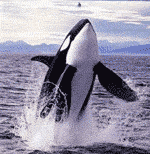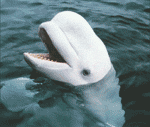Dolphins, porpoises, and whales
Order : Cetacea
 Thought to be once living on land, cetaceans have evolved to the aquatic life. Many cetaceans can dive for long periods and to great depths. Unlike humans, who can't dive too far down or stay under for too long or else too much nitrogen will be dissolved into our bodies, the cetaceans are not breathing pressurized air as is the scuba (self-contained underwater breathing apparatus) diver. The cetacean actually just holds its breath under water, so the air to be dissolved into its body, slowly decreases.The disease human divers can get from staying too long or too deep is called the caisson disease, altitude sickness, or the bends. A few cetaceans are believed to be the most intelligent non-primates and many have proportionately larger brains.
Thought to be once living on land, cetaceans have evolved to the aquatic life. Many cetaceans can dive for long periods and to great depths. Unlike humans, who can't dive too far down or stay under for too long or else too much nitrogen will be dissolved into our bodies, the cetaceans are not breathing pressurized air as is the scuba (self-contained underwater breathing apparatus) diver. The cetacean actually just holds its breath under water, so the air to be dissolved into its body, slowly decreases.The disease human divers can get from staying too long or too deep is called the caisson disease, altitude sickness, or the bends. A few cetaceans are believed to be the most intelligent non-primates and many have proportionately larger brains.
The order of cetaceans contains two sub-orders still in existence (the sub-order of ancient whales is extinct). These are Mysticeti (baleen whales) and the Odontoceti (toothed whales).
 The sub-order of Baleen whales consists of 11 species, the very large whales. The Blue Whale (Balaenoptera musculus) is the largest mammal (up to 30 meters or about 90 feet). It is also the largest mammal to have ever lived that we know of. Baleen whales are not known to dive to great depths, the fin whales are recorded to dive the deepest of the baleen whales to a maximum of about 355 m (1,165 ft.). That's nothing compared to sperm whales which can dive to depths of over 2,133 meters (7,000 ft) and can stay underwater for close to two hours. Baleen whales dives last anywhere from 3 to 20 minutes or more depending on the species.
The sub-order of Baleen whales consists of 11 species, the very large whales. The Blue Whale (Balaenoptera musculus) is the largest mammal (up to 30 meters or about 90 feet). It is also the largest mammal to have ever lived that we know of. Baleen whales are not known to dive to great depths, the fin whales are recorded to dive the deepest of the baleen whales to a maximum of about 355 m (1,165 ft.). That's nothing compared to sperm whales which can dive to depths of over 2,133 meters (7,000 ft) and can stay underwater for close to two hours. Baleen whales dives last anywhere from 3 to 20 minutes or more depending on the species.
 The sub-order of Odontoceti (toothed whales) is a much larger and more diverse group than the Baleen whales. It consists of 68 species which are small to medium in size, except for the sperm whales (the very large giant sperm whale reaches up to 18 m and weighs up to 53,000 kg). Like baleen whales, they make sounds, whistles and clicks, as a means of communication, and it is believed that these sounds are used for echolocation to find food and navigate. Toothed whales are social animals, orcas (killer whales) travel in social units called pods, containing one adult male, several adult breeding females and a number of sub-adults of both sexes. Sizes may vary from as few as 4 to as many as 40. Killer whales are most common in Arctic and Antarctic waters, but also occurs in all other oceans. They have an extremely varied diet, as far as animals living in the oceans are concerned, ranging from fish to birds, seals and even other whales.
The sub-order of Odontoceti (toothed whales) is a much larger and more diverse group than the Baleen whales. It consists of 68 species which are small to medium in size, except for the sperm whales (the very large giant sperm whale reaches up to 18 m and weighs up to 53,000 kg). Like baleen whales, they make sounds, whistles and clicks, as a means of communication, and it is believed that these sounds are used for echolocation to find food and navigate. Toothed whales are social animals, orcas (killer whales) travel in social units called pods, containing one adult male, several adult breeding females and a number of sub-adults of both sexes. Sizes may vary from as few as 4 to as many as 40. Killer whales are most common in Arctic and Antarctic waters, but also occurs in all other oceans. They have an extremely varied diet, as far as animals living in the oceans are concerned, ranging from fish to birds, seals and even other whales.
Picture of orca was taken from http://www.captivitystinks.org/
Links
http://animaldiversity.ummz.umich.edu/site/accounts/information/Cetacea.html
http://www.nhm.org/research/mammals/dolporp/cetbends.html
http://science.howstuffworks.com/question101.htm
http://www.encyclopedia.com/html/d1/decompre.asp
http://www.seaworld.org/infobooks/Baleen/home.html
http://www.earthlife.net/mammals/welcome.html

